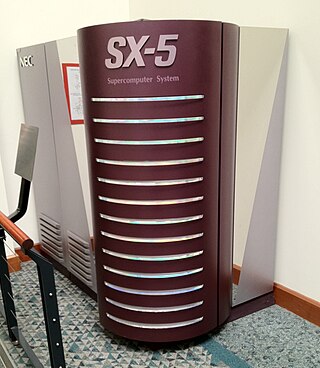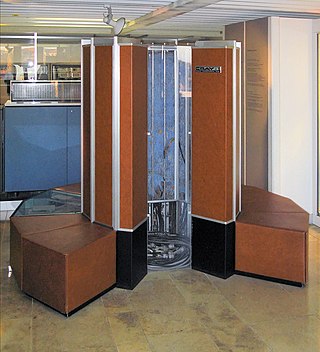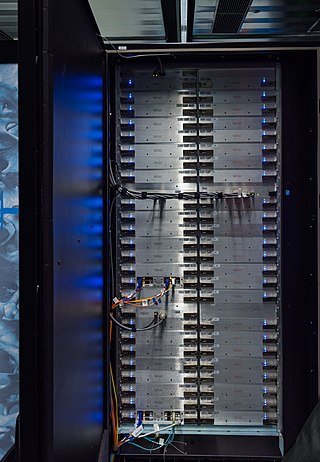
A supercomputer is a type of computer with a high level of performance as compared to a general-purpose computer. The performance of a supercomputer is commonly measured in floating-point operations per second (FLOPS) instead of million instructions per second (MIPS). Since 2022, supercomputers have existed which can perform over 1018 FLOPS, so called exascale supercomputers. For comparison, a desktop computer has performance in the range of hundreds of gigaFLOPS (1011) to tens of teraFLOPS (1013). Since November 2017, all of the world's fastest 500 supercomputers run on Linux-based operating systems. Additional research is being conducted in the United States, the European Union, Taiwan, Japan, and China to build faster, more powerful and technologically superior exascale supercomputers.
Floating point operations per second is a measure of computer performance in computing, useful in fields of scientific computations that require floating-point calculations.
The Earth Simulator (ES) is a series of supercomputers deployed at Japan Agency for Marine-Earth Science and Technology Yokohama Institute of Earth Sciences.

Blue Gene was an IBM project aimed at designing supercomputers that can reach operating speeds in the petaFLOPS (PFLOPS) range, with relatively low power consumption.

ASCI Red was the first computer built under the Accelerated Strategic Computing Initiative (ASCI), the supercomputing initiative of the United States government created to help the maintenance of the United States nuclear arsenal after the 1992 moratorium on nuclear testing.

NEC SX describes a series of vector supercomputers designed, manufactured, and marketed by NEC. This computer series is notable for providing the first computer to exceed 1 gigaflop, as well as the fastest supercomputer in the world between 1992–1993, and 2002–2004. The current model, as of 2018, is the SX-Aurora TSUBASA.

The TOP500 project ranks and details the 500 most powerful non-distributed computer systems in the world. The project was started in 1993 and publishes an updated list of the supercomputers twice a year. The first of these updates always coincides with the International Supercomputing Conference in June, and the second is presented at the ACM/IEEE Supercomputing Conference in November. The project aims to provide a reliable basis for tracking and detecting trends in high-performance computing and bases rankings on HPL benchmarks, a portable implementation of the high-performance LINPACK benchmark written in Fortran for distributed-memory computers.
In computing, performance per watt is a measure of the energy efficiency of a particular computer architecture or computer hardware. Literally, it measures the rate of computation that can be delivered by a computer for every watt of power consumed. This rate is typically measured by performance on the LINPACK benchmark when trying to compare between computing systems: an example using this is the Green500 list of supercomputers. Performance per watt has been suggested to be a more sustainable measure of computing than Moore's Law.

IBM Sequoia was a petascale Blue Gene/Q supercomputer constructed by IBM for the National Nuclear Security Administration as part of the Advanced Simulation and Computing Program (ASC). It was delivered to the Lawrence Livermore National Laboratory (LLNL) in 2011 and was fully deployed in June 2012. Sequoia was dismantled in 2020, its last position on the top500.org list was #22 in the November 2019 list.
QPACE is a massively parallel and scalable supercomputer designed for applications in lattice quantum chromodynamics.

Exascale computing refers to computing systems capable of calculating at least 1018 IEEE 754 Double Precision (64-bit) operations (multiplications and/or additions) per second (exaFLOPS)"; it is a measure of supercomputer performance.

The K computer – named for the Japanese word/numeral "kei" (京), meaning 10 quadrillion (1016) – was a supercomputer manufactured by Fujitsu, installed at the Riken Advanced Institute for Computational Science campus in Kobe, Hyōgo Prefecture, Japan. The K computer was based on a distributed memory architecture with over 80,000 compute nodes. It was used for a variety of applications, including climate research, disaster prevention and medical research. The K computer's operating system was based on the Linux kernel, with additional drivers designed to make use of the computer's hardware.

Tsubame is a series of supercomputers that operates at the GSIC Center at the Tokyo Institute of Technology in Japan, designed by Satoshi Matsuoka.

The history of supercomputing goes back to the 1960s when a series of computers at Control Data Corporation (CDC) were designed by Seymour Cray to use innovative designs and parallelism to achieve superior computational peak performance. The CDC 6600, released in 1964, is generally considered the first supercomputer. However, some earlier computers were considered supercomputers for their day such as the 1954 IBM NORC in the 1950s, and in the early 1960s, the UNIVAC LARC (1960), the IBM 7030 Stretch (1962), and the Manchester Atlas (1962), all of which were of comparable power.

Several centers for supercomputing exist across Europe, and distributed access to them is coordinated by European initiatives to facilitate high-performance computing. One such initiative, the HPC Europa project, fits within the Distributed European Infrastructure for Supercomputing Applications (DEISA), which was formed in 2002 as a consortium of eleven supercomputing centers from seven European countries. Operating within the CORDIS framework, HPC Europa aims to provide access to supercomputers across Europe.

Approaches to supercomputer architecture have taken dramatic turns since the earliest systems were introduced in the 1960s. Early supercomputer architectures pioneered by Seymour Cray relied on compact innovative designs and local parallelism to achieve superior computational peak performance. However, in time the demand for increased computational power ushered in the age of massively parallel systems.
The PRIMEHPC FX10 is a supercomputer designed and manufactured by Fujitsu. Announced on 7 November 2011 at the Supercomputing Conference, the PRIMEHPC FX10 is an improved and commercialized version of the K computer, which was the first supercomputer to obtain more than 10 PFLOPS on the LINPACK benchmark. In its largest configuration, the PRIMEHPC FX10 has a peak performance 23.2 PFLOPS, power consumption of 22.4 MW, and a list price of US$655.4 million. It was succeeded by the PRIMEHPC FX100 with SPARC64 XIfx processors in 2015.

The Cray XC40 is a massively parallel multiprocessor supercomputer manufactured by Cray. It consists of Intel Haswell Xeon processors, with optional Nvidia Tesla or Intel Xeon Phi accelerators, connected together by Cray's proprietary "Aries" interconnect, stored in air-cooled or liquid-cooled cabinets. The XC series supercomputers are available with the Cray DataWarp applications I/O accelerator technology.
The Sunway BlueLight (神威蓝光) is a Chinese massively parallel supercomputer. It is the first publicly announced PFLOPS supercomputer using Sunway processors solely developed by the People's Republic of China.

Fugaku(Japanese: 富岳) is a petascale supercomputer at the Riken Center for Computational Science in Kobe, Japan. It started development in 2014 as the successor to the K computer and made its debut in 2020. It is named after an alternative name for Mount Fuji.












